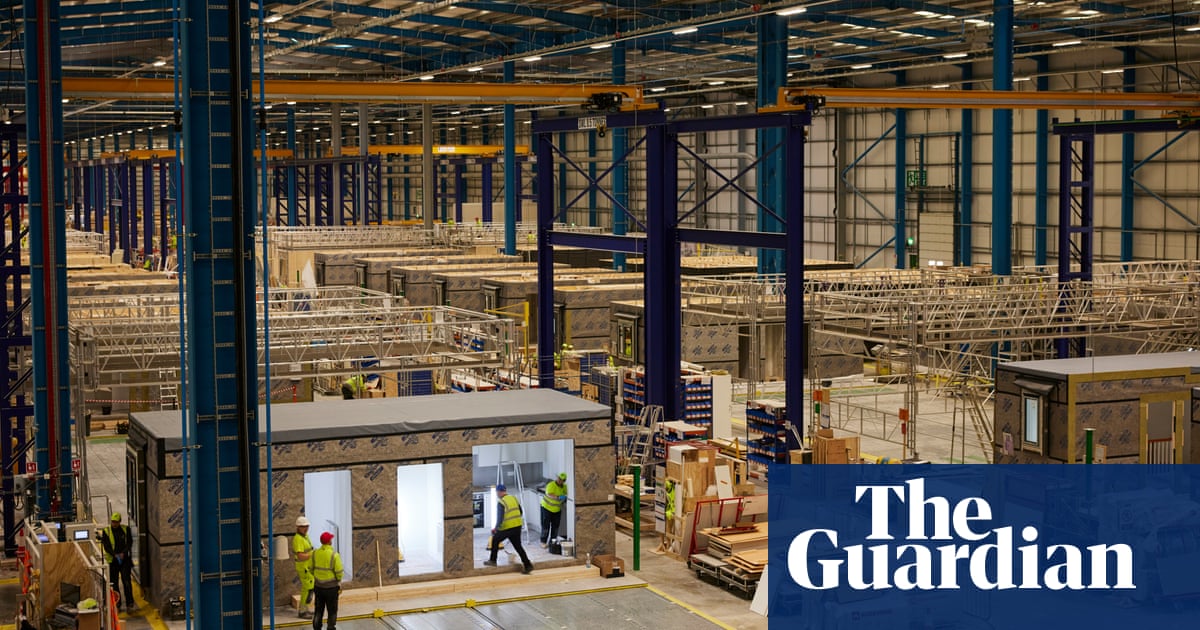
Resembling a giant toymaker’s workshop, 16 identical wooden boxes that stand 2.6 metres tall are lined up in a row in a factory near Leeds.
Each year the factory manufactures hundreds of apartments and houses, with one to three bedrooms, which leave the premises on lorries fully kitted out. The factory is run by one of Britain’s biggest insurance and pension firms, Legal & General, and is one of the main modular housing makers in the country.
Compared with countries such as Japan and Germany, where modular housing is more established, this is a nascent industry in Britain and is still largely loss-making. But the hope is that the building of good-quality homes faster might be part of a long-term solution to Britain’s housing crisis.
Some people may still associate modular homes, made on a factory assembly line like a car, with the prefab homes of the 1950s and 1960s – accommodation that was hastily assembled after the war and built to last just 10 years. But today’s timber frame modular homes are better quality and more energy efficient.
Modular homes are in the top energy performance bracket, so could save an average household up to £800 a year on energy bills, according to the industry group Make UK Modular.
Thomas Chambers, a 38-year-old IT consultant, moved into a £250,000 three-bedroom, end of terrace, modular house at L&G’s Selby site in September. He had known nothing about modular housing but was attracted by the style, location and energy efficiency. His energy bills are about the same as they were for his previous, smaller, 1980s terrace house in Wakefield because his new home retains heat much better and has solar panels.
“I’ve been very happy living here so far. One of the things I like about the property is the high ceilings, which are I think a foot higher than a typical new-build property,” he said.
Rosie Toogood, chief executive of L&G Modular Homes, said: “When people see that’s a modular home it expunges the picture … a prefab in black and white. The more people can see those homes and live in those streets and know that those modular homes are really nice, then momentum will build and there will be more acceptance.”
However, L&G has run into problems at its Bonnington site, in Bristol, where it is building 185 modular homes, a mix of flats and houses, but has faced issues with the foundations, which has led to a 12-month delay. L&G hopes to complete the homes early next year. Some of the 30 customers who have reserved houses reportedly have been offered compensation of up to £4,000.
In Selby, at L&G’s first modular site which has got 100 homes, some modules were left exposed to the elements and developed mould on the internal plasterwork while the company awaited the arrival of roof trusses and tiles, delayed by supply chain problems. A handful of houses and the 16-home apartment block were affected, and are being stripped back completely to remove damp and mould and repaired before being handed over to buyers.
Toogood acknowledges that L&G has work to do to regain trust. “Like every other builder, we’ll have issues. We’ve just got to make sure we learn from it and make sure we don’t repeat it [the mistakes].”
In the factory, a crane is used to place the ceiling on to a house while workers fit the electrics. In the construction process two giant Italian machines cut cross-laminated timber walls with openings for doors and windows, and the small square holes for the switches.
It takes just 14 days at the L&G factory to build the two modules that make up a two-bedroom house. Dispatched on the back of lorries and bolted together on site, a house comes complete with staircases, windows, doorways, fully equipped kitchen and bathroom, and sockets, radiators and heat pump. The roof is hoisted into place, brick cladding added to the outside walls and the interiors are finished off within about 12 weeks.
L&G aims to produce 450 homes at the factory this year, but could increase this to 3,000 annually.
Another modular firm, the Goldman Sachs-backed Top Hat company, is creating its second housing site near Corby. The size of 11 football pitches, it is set to be the biggest 3D modular housing factory in western Europe. The firm plans to build 4,000 homes a year.
“If you think about assembling a car, doing it in a factory is much more efficient than if you build it outside your garage,” said Steve Cole, director of Make UK Modular. “It’s about manufacturing process. We’re used to construction being a fairly unreformed process. A building site today looks a lot like a building site 100 years ago, whereas a car plant is entirely different.”
While the production process is a bit like playing with giant Lego blocks, at least from the viewing gallery, there is nothing to distinguish L&G’s yellow-brick-clad houses in nearby Selby from other homes in the neighbourhood. All but three of the Selby homes have been sold, with 31 offered at affordable rent or shared ownership.
The prices range from between £195,000 and £210,000 for a two-bed house to between £240,000 and £260,000 for a three-bed, the prices being similar to those for other houses in the area. L&G says the homes are EPC (energy performance certificate) A-rated and should save residents about £1,534 a year in energy bills.
L&G’s business has made slower progress than expected, though, running up cumulative losses of £176m since it was set up, in 2016, by the insurer’s outgoing chief executive, Nigel Wilson. Its parent has injected £182m into it over that period.
Several other modular housing firms are also in the red, including Top Hat, and three went bust last year, while a few are profitable, such as the Bedford-based Vision Modular Systems. Founded in 2011 by Irish businessman John Fleming, it completed a 44-storey steel-frame tower in Croydon last October, the tallest modular building in the world.
The upfront cost of setting up and running a factory is high, but Toogood hopes the L&G division will turn a profit within the next two years.
Affordable housing is one of the areas that L&G believes could benefit from the hundreds of billions of pounds of capital set to be released through the reform of so-called solvency II regulations. Through a reduction of the amount of capital that insurers like L&G must hold in light of future payouts, the industry expects about £100bn to be available for green energy and social infrastructure projects, including modular homes.
But while the changes have been sold to the government as a way to boost funding for infrastructure projects, there are no rules requiring that money be used for those projects, let alone kept in the UK. Some firms suggest that the government needs to create more investable projects, but without promised capital, there remains a chicken-and-egg conundrum.
Make UK Modular has calculated that the industry will be able to build 20,000 modular homes by 2025. This would equate to a fifth of the 100,000 annual shortfall – the government has set a target of 300,000 new homes a year by 2025. About 204,500 were built in the year to March 2022, official figures show.
Make UK Modular says that 3,300 modular homes were built in 2022, one in 60 of every new home constructed.
Toogood said: “Five years from now, the modular industry will be a significant part of how we deliver homes in the UK.”












